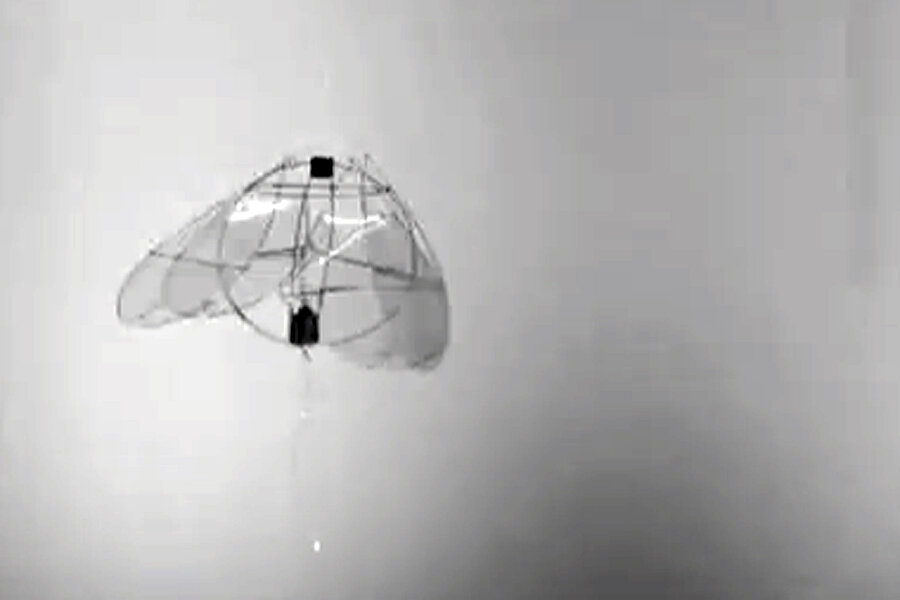Flying 'jellyfish' robot could mean big things for future surveillance, search-and-rescue technology
Loading...
The future of flying miniaturized robots has taken a squishy turn.
Researchers at New York University have developed a miniature robot that stays in flight with movements similar to those of a swimming jellyfish.
The small prototype weighs just two grams and stays afloat with four wings that flap up and down – similar to the movements of a bobbing jellyfish.
"Our guy sort of squeezes his wings together to shoot air down to generate the lift to keep it up in the air," says Leif Ristroph, a professor at NYU who led the research. Similar, he says, to the way a jellyfish squeezes and contracts its bell to propel forward in water.
The flying jellyfish could usher in an era of small flying robots used for search-and-rescue missions, surveillance, and traffic monitoring.
"There's a lot of interest in building the sort of small scale maneuverable hovering air vehicles," Ristroph says. "Most of them are directly inspired by insects, meaning they actually have some mechanism that beats wings the way an insect beats its wings. The concept behind our vehicle was to think of new ways to fly, basically. Ways that may not show up in nature, and to see if there was any advantage for that."
Researchers have long been trying to create small aerial robots. In the past, these devices have mimicked flying insects such as the fruit fly. In May, Harvard researchers created a tiny "RoboBee" that buzzed through the air with wings that flapped 120 times per second. It was the first controlled flight of an insect-like robot, but it still required a control system to work.
Unlike a mindless robot, a real fly constantly assesses its environment, adjusting its movement to every breeze or approaching object. The Harvard team used a "delicately balanced" control system to react to airflow changes so that the bug could remain stable.
"If an insect were to just keep beating its wings the way it normally beats its wings, it would basically spin out of control," Ristroph explains. "Its body would tumble out of the air. To get around that, what a fly does is it has sensors, and so it can sense when its body is beginning to get reoriented…and then it makes compensating wing motions."
But a complex control system is difficult to recreate in such a small device, Ristroph says. High-speed cameras film the object when it's in the air, and the robot receives information from the cameras to determine how to correct its motion in order to keep its stability.
Unlike RoboBee, the jellyfish robot shows stability without the help of a control system. Ristroph says this simple design, without the use of complex control systems, could help researchers as they miniaturize these devices further.
"I think that simple strategy is going to work on a very small scale," he says.
The device, presented at an American Physical Society meeting on Sunday, still needs to be hooked to a power source and cannot steer its direction. But Ristroph says the device has a handful of applications – including air quality control and search missions in dangerous areas.
The team's jellyfish inspiration is not entirely irrelevant – recent research has found that moon jellyfish are actually remarkably efficient swimmers. The "quintessential jellyfish" species moves with a series of contractions, squeezing its muscles and then releasing them to float along.
A water vortex swirls behind the jelly after it relaxes its muscles, giving it an additional boost with no added effort. With this process, the moon jellyfish, although quite slow, actually uses much less energy to cover a certain distance than a slick salmon.
Ristroph says scientists should be open-minded and try different ways of flight. There were some "pretty wacky designs" for airplanes, he says, and eventually one idea wins out.
"So far, there's only been this one idea of 'let's copy insects,' and we know from the airplane that we didn’t copy birds," he says. "I mean some people tried that, but there’s also lots of other ideas that we tried."






